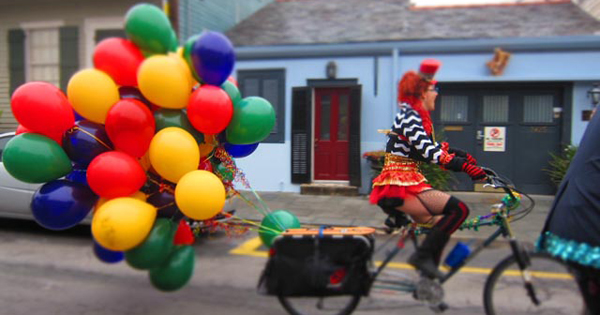
The last two Mardi Gras have been bitingly cold by New Orleans standards. It was 36 degrees and windy when I awoke last Tuesday, which brought to mind last year’s Mardi Gras, when it was 36 degrees and rainy. So I slept in for a while, then puttered around the house. When my wife and I finally rallied to bicycle downtown, we were tens of thousands of costumes late.
But not too late. It’s about five miles from where we live to the Marigny, our favorite neighborhood to start the day. And getting from here to there, pedaling through a mix of commercial and residential neighborhoods, also involves passing through several layers of Mardi Gras, each strikingly different. It’s like descending stratum by stratum into the Grand Canyon.
Affluent New Orleans comes out for the Rex parade on upper St. Charles Avenue. This is the last major parade of the season and features the King of Carnival, who rides down St. Charles waving regally at his subjects. When the Times-Picayune used to be a paper that came to our house every day, our Mardi Gras would start by poring over the front page, which was devoted to the winning personality and good civic works of the king. A real newspaper reporting in depth on a fake king set the stage for a day of disbelief.
Past Jackson Avenue, we catch up with the Zulu parade, a mostly African-American celebration, in which float black riders wear blackface, grass skirts, and fright wigs and toss painted and glittered coconuts to parade goers. (See “Day of Disbelief,” above.) Hereabouts we might also hear drumming and see Mardi Gras Indians, also African American, in flamboyant handmade feather-and-bead costumes loosely inspired by the ceremonial outfits of Native Americans. They flow unexpectedly out of side streets, a rivulet of color and noise emerging from a side canyon.
Then it’s across wide Canal Street, where the wind eddies and swirls insistently; steel parade barricades have collected drifts of empty plastic bead wrappers and other windblown detritus. Thence into the Bourbon Street Mardi Gras, the “boobs, beer, and beads” mutation that most of America associates with the day thanks to shiftless media coverage.
Many on Bourbon Street appear to subscribe to the belief that that the loudest person wins Mardi Gras. Dudes of every age drift about, drinks in hand, occasionally erupting in whoops, but mostly scanning furtively for female public nudity. The odds of spotting this are actually less than you might think. I’m guessing the instant uploads to social media and the professional consequences thereof have led to a falloff. But maybe it’s just the cold weather.
Then it’s through several blocks of gay Mardi Gras, where costumes can be so elaborate as require their own support staff, and into the Marigny and Bywater, two neighborhood that have undergone sweeping demographic change but still have boho cred. Here we find what might be called the hipster Mardi Gras, a loose amalgam of colorful walking parades and hand-pushed floats. Often led by brass bands, these dribble out of scruffy neighborhoods before merging into a substantial river on Royal Street and then into the lower Quarter.
“Hipster” is uniformly pejorative everywhere these days, of course, but a friend of mine insists that hipsters should be given credit for their love of constantly making things—artisanal pickles, furniture out of old books, hoppy beer, whatever—in contrast to their hippie forebears, who just smoked weed and had sit-ins. And Mardi Gras offers a garden where these creative impulses can flower fully—you rarely see store-bought costumes, and many marchers are clad in extraordinary outfits that have taken weeks to conceive and craft. This is my favorite part of Mardi Gras: it becomes an arts festival where the line between spectator and artist is erased. Those in street clothes are regarded as aberrant freaks.
“This city is capable of moments unlike any moments you’ll ever experience in life,” David Simon, the producer of respected HBO series The Wire and Treme, once told The New York Times. New Orleanians are “artists with a moment, they can take a moment and make it into something so transcendent that you’re not quite sure that it happened or that you were a part of it.”
That’s true in every stratum of Mardi Gras, and everyone who lives here has a favorite Mardi Gras moment. Mine occurred six years ago, when I was catching up with friends at Jackson Square, in the center of the French Quarter. Crowds milled about in a sort of congenial chaos. About a hundred feet away a dozen or so fundamentalists held aloft signs reading “Homo Sex is Sin,” “Repent of Your Wicked Heart of Unbelief,” and the like, haranguing the crowd through a powered megaphone.
Then I saw a group of about two dozen pirates emerge from behind the cathedral, pushing a minivan-sized, handmade pirate ship and three bead cannon. The bead cannon were homemade and involved six feet of PVC pipe painted black, with slingshots inside made of surgical tubing and funnels. Plastic beads would be loaded in the barrel like grapeshot, the tubing stretched, the beads released. These could easily soar a full city block.
“Captain, request permission to besiege the Christians!” came a clarion call from one of the pirates. “Permission granted!” came the reply, and the pirates arrayed their bead cannon in a line and started enfilading the evangelists with gold and purple projectiles. Those under fire quickly formed a defensive scrum and huddled under a turtle shell of pasteboard signs.
After several minutes of barraging, the siege was called off. The pirates rolled on in search of further adventure. The fundamentalists fired up the megaphone to enumerate the wickedness of our ways. No clear victor emerged.
Unless you count the few dozen of us watching this episode unfold, and who needed no convincing that a year without a day of disbelief is no year at all.


